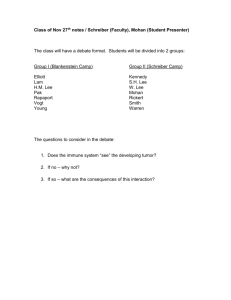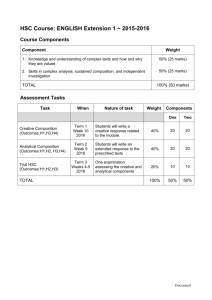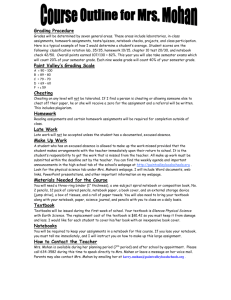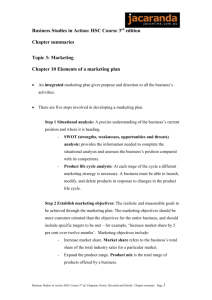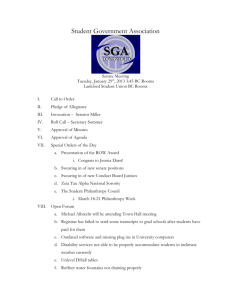Operations Management Overview: HSC Business Studies
advertisement
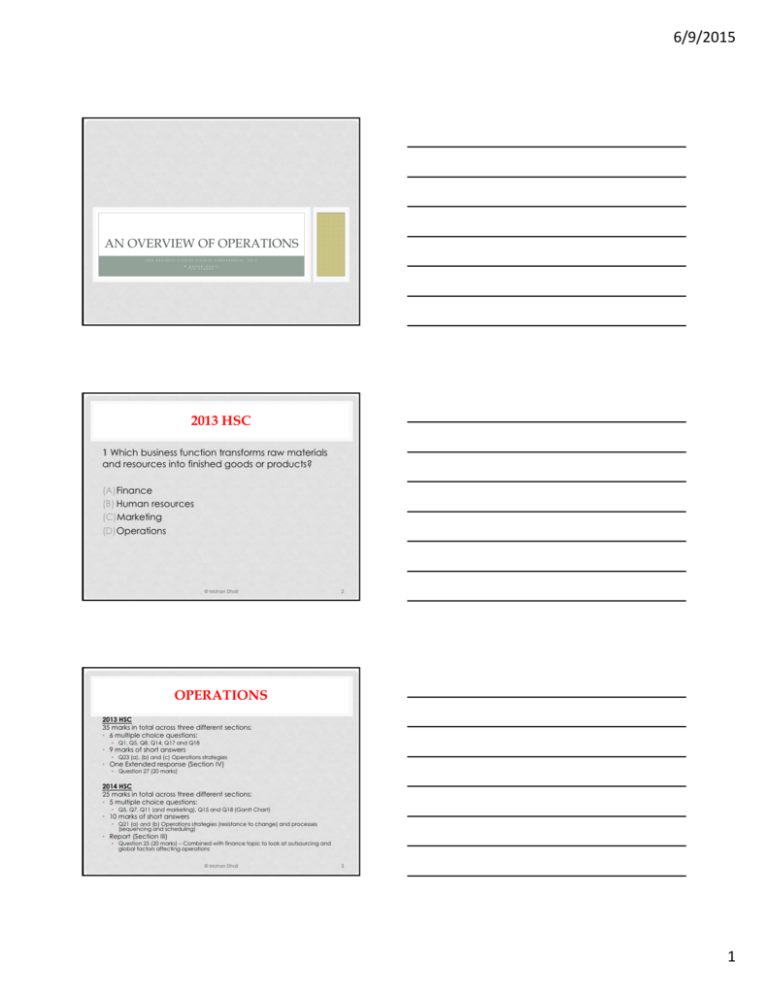
6/9/2015 AN OVERVIEW OF OPERATIONS U O W B U S I N E S S S T U D I E S © S T U D E N T C O N F E R E N C E S , 2 0 1 5 M O H A N D H A L L P L C S Y D N E Y 2013 HSC 1 Which business function transforms raw materials and resources into finished goods or products? (A)Finance (B) Human resources (C)Marketing (D)Operations © Mohan Dhall 2 OPERATIONS 2013 HSC 35 marks in total across three different sections: • 6 multiple choice questions: • Q1, Q5, Q8, Q14, Q17 and Q18 • 9 marks of short answers • Q23 (a), (b) and (c) Operations strategies • One Extended response (Section IV) • Question 27 (20 marks) 2014 HSC 25 marks in total across three different sections: • 5 multiple choice questions: • Q5, Q7, Q11 (and marketing), Q15 and Q18 (Gantt Chart) • 10 marks of short answers • Q21 (a) and (b) Operations strategies (resistance to change) and processes (sequencing and scheduling) • Report (Section III) • Question 25 (20 marks) – Combined with finance topic to look at outsourcing and global factors affecting operations © Mohan Dhall 3 1 6/9/2015 ROLE OF OPERATIONS MANAGEMENT • Strategic role of operations management Operations is intrinsically and intricately linked with each of the the other key business functions. This is crucial to understand. Management perspectives are important. © Mohan Dhall 4 ROLE OF OPERATIONS MANAGEMENT • Cost leadership • Two aspects apply • Efficiency – cost-minimisation • Note the relationship between supply costs and cost leadership • Delivering product to the market in a price-competitive manner • Case studies: • International • WalMart: “Save money. Live better.” • Aldi and Trader Joes (USA) – note SCM implications • Australian • Big W, K-Mart, CostCo • Ford, Holden vs Mazda and Toyota © Mohan Dhall 5 ROLE OF OPERATIONS MANAGEMENT • Good/service differentiation • Distinguishing between goods and services • Goods and/or services in different industries • The different levels of processing: intermediate and final goods • The interaction between goods and services Case study: http://sydneyskin.com/cosmetic-dermatology/ © Mohan Dhall 6 2 6/9/2015 INFLUENCES ON OPERATIONS • Globalisation • Coca Cola • Technology • Black Milk Clothing, Tencent • Quality expectations Mercedes Benz, Rodd and Gunn • Cost-based competition • Aldi, Walmart, TATA Motors • Government policies • Multigate, Simpson • Legal regulation • Environmental sustainability • Legal regulation • Alcohol and tobacco retailers – CUB and British American Tobacco • Environmental sustainability • Westpac © Mohan Dhall 7 INFLUENCES ON OPERATIONS Globalisation: • • • • • Aldi, IKEA, Rio How business operations are structured How businesses source their supplies (SCM)/distribute their products How global businesses compete IP issues Technology • • • • Technologies used in manufacturing processes for sourcing (B2B) Technologies used in creating services, accessing markets (B2C) Technologies used to manage inventory Technologies used to manage quality • https://blackmilkclothing.com/collections/all © Mohan Dhall 8 INFLUENCES ON OPERATIONS Quality expectations • ISO definition of Quality: “the totality of features and characteristics of products (goods) and services that bears its ability to satisfy stated or implied needs” Must distinguish between quality for goods and quality of services • Goods: • Design (including functionality, materials, innovation), fitness for purpose, durabilit: http://www.rolex.com/y • Customisation, reliability and competence of the service provider, overall levels of professionalism and standard of care • Services: peoples, processes and physical evidence © Mohan Dhall 9 3 6/9/2015 INFLUENCES ON OPERATIONS Cost-based competition (note: cost-leadership) Relies on efficiencies, scale, waste minimisation, use of technologies Government policies and legal regulation (Compliance or regulatory costs) • Health and safety – products and businesses based on • Workplace Health and Safety (WHS), environmental laws, transport laws, anti-discrimination laws, fair trading laws (including implied conditions such as fitness for purpose and merchantable quality) • Multigate Medical Supplies • http://www.multigate.com.au/about/videos-and-corporateprofile Environmental sustainability • Principles of ESD © Mohan Dhall 10 INFLUENCES ON OPERATIONS Corporate social responsibility (CSR) • The business dilemma: • What is the purpose of business? • What is the nature and effect of compliance? • The difference between legal compliance and ethical responsibility – Including environmental sustainability and social responsibility • Case study: • Westpac vs Cootes Transport © Mohan Dhall 11 OPERATIONS PROCESSES An overview of the processes Inputsintothe transformationprocess: WHATINPUTS • Labour,rawmaterials, energy,information, technologies • Transformedresources • Material,information customers • Transformingresources • Humanresources,facilities Operationsprocesses andtransformingfactors • Influenceofthe4V’s • Sequencingandscheduling processingactivities • Roleoftechnologyin processing • Plantandofficelayout • Monitoring,controllingand improvingprocesses © Mohan Dhall Outputs: Finalgoodsandservicesthat aresoldtomarkets: (intermediateandconsumer) • Customerservice • Warranties 12 4 6/9/2015 OPERATIONS PROCESSES A: Inputs 1. Transformed resources 2. • Materials, information, customers Transforming resources • Human resources, facilities – agents of transformation/change/value-adding B: Transformation processes The influence of the 4 V’s: • • • • Volume: business issue – how much to make?, capacity management Variety – a mature product strategy, ‘mix flexibility’, diversification Variation in demand – analytics (KPIs) and demand predictions Visibility (customer contact) – what, if any, influence customers have on transformations processes – responsiveness of processing Case study: KFC, Vodafone © Mohan Dhall 13 2013 HSC 17 Which of the following combinations would result in the lowest production cost per unit? (A)Limited customer contact, limited product variety and low volume (B) Limited customer contact, limited product variety and high volume (C)Extensive customer contact, extensive product variety and low volume (D)Extensive customer contact, extensive product variety and high volume © Mohan Dhall 14 OPERATIONS PROCESSES Sequencing (what order) and scheduling (when and for how long): • Process and resource management tools • Gantt charts, critical path analysis (CPA) © Mohan Dhall 15 5 6/9/2015 2013 HSC 8 What does a critical path identify? (A)The lowest cost path to complete all tasks in a project (B) The highest cost path to complete all tasks in a project (C)The longest time required to complete all tasks in a project (D)The shortest time required to complete all tasks in a project © Mohan Dhall 16 OPERATIONS PROCESSES Technology • Production (manufacturing) technologies: CIM, CAD, CAM, Robotics • Service technologies: ICTs, laptop and desktop computers and associated software. Note technologies are used in a huge range of service industries: • Professional: medical, engineering, architecture • Trades: plumbing (optical fibre technology), carpentry (laser cutting) Task design • Overlaps with HR: analysing what needs to be done (creates a job/duty statement), leads to an analysis of the desired skills, abilities, attributes, qualifications and experiences Process layout • (Aside: note the bias of the syllabus towards goods manufacture) • Process layout is a reference to plant • There are various forms of layout relevant to production: process (functional layout), product (for mass production of standardised goods), fixed position layout • Services layout includes office layout and how services are conducted and carried out © Mohan Dhall 17 OPERATIONS PROCESSES C: Outputs • Customer service • Operations processes - implications • Outsourcing • Warranties • A quantitative (measurable) assessment of operations processes • Effect on inputs and processes • Case study: • The recall of 8.1 million Toyotas following slipping mats and sticky accelerators being linked to 19 accident deaths. Honda recalling 437,000 vehicles due to faulty airbags. • See also: VW (Skoda and Audi) © Mohan Dhall 18 6 6/9/2015 2012 HSC AND 2014 HSC 2 A factory manager is deciding the best order in which to complete tasks. Which operations process is being carried out? (A) (B) (C) (D) Monitoring Scheduling Sequencing Task design 18 A Gantt chart for Sam’s Chocolate Shop is shown. Jan Feb March April May June Obtain lease and refit shop Purchase stock Select and train staff Advertising campaign Commence trading © Mohan Dhall 19 2012 HSC AND 2013 HSC 7 In winter, the number of beach lifeguards employed by a local council is reduced. What has influenced the transformation process in this situation? (A) (B) (C) (D) Variation in demand Variation in visibility Variety Volume 14 Which of the following includes two examples of transforming resources? (A) (B) (C) (D) Materials and energy Information and customers Task design and technology Human resources and facilities © Mohan Dhall 20 OPERATIONS STRATEGIES Performance objectives (all quantifiable) • Quality • design quality, service quality and consistency, quality standards and conformance rates • Speed • The notion of ‘lead times’ is relevant. This implies supply chain management controls, flexible processing (in response to demand) and reduction of processing and delivery bottlenecks • Dependability • Flexibility • Market responsiveness and service customisability • Customisation • Both goods and service providers aim to standardise their operations as far as possible. The proportion of standardisation is linked with cost savings • Cost • Cost leadership (expense minimisation) and therefore low-cost delivery of product to markets is most likely to maximise profitability New product or service design and development • Involves research and development (R&D), product design, product/market testing, product refinement/adjustment, delivery to market and ongoing adaptation. © Mohan Dhall 21 7 6/9/2015 2014 HSC 5 Which of the following are all examples of operations performance objectives? (A) (B) (C) (D) Choice, flexibility, profit, speed Cost, dependability, quality, speed Customisation, flexibility, profit, quality Choice, customisation, dependability, profit 11 An Australian business sells its Bonza Pies in both Australia and China. Bonza Pies sold in China are made to a different recipe. What is this an example of? (A) (B) (C) (D) Customisation and hedging Global pricing and standardisation Customisation and global branding Global branding and standardisation © Mohan Dhall 22 OPERATIONS STRATEGIES Supply chain management (SCM) • Logistics (note in order of processes this should be dealt with LAST) • Involves distribution (channels) • Involves transportation modes • The role, if any, or warehousing • E-commerce • E-procurement (B2B) • E-tailing (B2C) • Global sourcing • Global web • Make-or-buy and vertical integration © Mohan Dhall 23 2012 AND 2013 HSC 11 Which of the following is an essential aspect of logistics? (A) (B) (C) (D) Undertaking a skills audit Checking the quality of all output Materials handling and packaging The creation of a budget for new machinery 5 A company’s policy is to purchase from lowest cost suppliers regardless of their location. What is this policy an example of? (A) (B) (C) (D) Global sourcing Global branding Economies of scale Research and development © Mohan Dhall 24 8 6/9/2015 OPERATIONS STRATEGIES Outsourcing (the most underrated strategy and most widely used) • Advantages • • • • • • Cost saving/efficiency Increased ability to process – functional/capacity increases = growth Flexibility Through Service Level Agreements (SLA’s) – specified standards Access to process/knowledge experts Strategic benefits (eg British Airways ticketing with WNS) • Disadvantages • • • • • • Possible loss of privacy Cost of outsourcing Negotiating SLA’s Loss of control of business processes Cost of organisational redesign Loss of corporate memory Case studies: Mattel and Apple – breaches to SLA’s..? Insourcing trend - cosourcing © Mohan Dhall 25 OPERATIONS STRATEGIES Inventory management (stock management) • Advantages and disadvantages of holding stock • Warehousing and attendant costs (leasing, rent or interest, security, insurance, refigeration/air temp and quality controls, logistics management) • JIT and the interaction between the holding of stock and distributing stock (they are NOT mutually exclusive) • LIFO (last-in-first-out), FIFO (first-in-first-out) • Inventory costing techniques • JIT (just-in-time) • Assumptions: Periodic period (rather than perpetual), matching principle is CRUCIAL © Mohan Dhall 26 2013 AND 2014 HSC 18 A business is experiencing increasing costs for its stock over time. It is seeking to maximise its profit for the current financial period. Which strategy should it adopt to value its inventory? (A) (B) (C) (D) First in first out Just in case Just in time Last in first out 7 A car assembly plant had to shut down operations for a day because tyres had not been delivered. What inventory management strategy at the car assembly plant may have caused this situation? (A) Just-in-case (B) Just-in-time (C) First-in-first-out (D) Last-in-first-out © Mohan Dhall 27 9 6/9/2015 OPERATIONS STRATEGIES Quality management • International quality principles (ISOs) • Dynamic NOT static processes • TQM: Product excellence and Sigma Six: Process excellence • Both are old…and new again • Control (QC) • Predetermined quality - random sampling • Assurance (QA) • Pre-determined quality standards • International Standards Organisation (ISOs) • Improvement (QI) • Continuous not discontinuous © Mohan Dhall 28 OPERATIONS STRATEGIES Overcoming resistance to change • Financial costs* • • • • purchasing new equipment redundancy payments retraining reorganising plant layout • Inertia • Psychological resistance to change • Case studies • David Jones and e-commerce, News Limited and Fairfax * Note the implied bias towards manufacturing © Mohan Dhall 29 2014 HSC Question 21 (10 marks) (a)Explain why managers may be resistant to change. 4 (b)Analyse the use of sequencing and scheduling to improve business operations. 6 © Mohan Dhall 30 10 6/9/2015 OPERATIONS STRATEGIES • Global factors • Global sourcing: • K-Mart and Bunnings • Testrite • Economies of scale: • CostCo, Walmart, Aldi • Scanning and learning: • Ladbrokes and Tom Waterhouse • Research and development (R&D) • Case study: CSL © Mohan Dhall 31 2014 HSC 15 What is the most likely result of a business achieving economies of scale? (A) Greater flexibility (B) Higher sales price per unit (C) Greater efficiencies in production (D) Higher average costs of production © Mohan Dhall 32 HSC 2013 - Q23 (9 MARKS) Casey owns and operates an independent discount f uel and convenience store. (a)Outline ONE way that ecommerce could assist Casey with supply chain management. 2 (b)Explain ONE performance objective that is relevant to the operations function of the business. 3 (c) Is supply chain management important to Casey’s business? Justify your answer. 4 © Mohan Dhall 33 11 6/9/2015 HSC 2012 –REPORT Question 25 (20 marks) Sunshine Fruit Juices employs 100 people in its Queensland factory and supplies juice to large supermarket chains in Asia and North America. Customers have recently complained that the product has been damaged and bottles have been wrongly labelled. An increase in industrial disputes has also occurred due to a number of recent workplace accidents and demands from employees for higher wages. You have been employed by Sunshine Fruit Juices to prepare a report for management on the issues outlined above. In your report, recommend strategies for human resources and operations that the firm could implement to improve its business performance. © Mohan Dhall 34 2014 HSC REPORT Question 25 (20 marks) Emu Uniform Manufacturers Pty Ltd are a successful business based in NSW. They currently supply a range of school, sport and work uniforms to a large number of customers throughout Australia. They are known for their outstanding customer service and high quality products. Sales have been increasing for many years and they have recently received a large long-term contract to supply uniforms to a major company. This will require them to significantly expand their output. To do this, the business will have to outsource overseas or spend $5 million to expand its existing factory in NSW. You have been hired as a consultant to write a report to the management. In your report: • recommend a source of finance for the factory expansion • discuss outsourcing overseas compared with the factory expansion • explain the global factors that need to be considered if they decide to use outsourcing as an operations strategy. © Mohan Dhall 35 HSC QUESTIONS - SECTION IV 20 marks Attempt either Question 27 or Question 28 Allow about 35 minutes for this section Answer the question in a SEPARATE writing booklet. Extra writing booklets are available. In your answer you will be assessed on how well you: • demonstrate knowledge and understanding relevant to the question • apply relevant business case study/studies and contemporary business issues • communicate using relevant business terminology and concepts • present a sustained, logical and cohesive response Question 27 (20 marks) How does an understanding of the influences on operations contribute to business success? HSC 2013 Question 27 (20 marks) Assess strategies that management may use to respond to influences on operations. © Mohan Dhall 36 12
